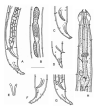|
 |
Females:
- Cuticle thin, annulated.
- Lateral field 4.5-5.5 um wide at midbody;, consisting of two
separate wings divided by striated cuticle, fading anteriorly at level
of pharyngeal corpus and ending near tail terminus.
- Deirid setiform, at level of excretory pore, inside lateral field.
- Pharyngeal region with 11-14 somatic setae; body remainder with 13-
17 somatic setae
- Anterior end with pronounced bilateral and dorsoventral symmetry;
Cervical cuticular expansions with 9-13 annules, extending backward to
the level of the four postcephalic setae
- Cornua flattened, leaf-shaped with finely rounded terminus,
- Subdorsal and subventral lip pairs modified into two median
ridges, each with a pair of submedian flaps of cuticle, projecting
forward and inward.
- Lateral lips modified, bearing two sublateral cuticular plates
shaped like large quadrants. Lateral lips midlaterally extending in
between quadrants, each forming a tapering tip, containing a nerve
ending.
- Amphidial aperture 2 um wide, circular, located at about half of
stoma length.
- Stoma plectoid.
- Pharyngeal corpus cylindrical, plump, Isthmus plump,
surrounded by nerve ring at its anterior end and by renette cell at its
posterior end.
- Basal pharyngeal bulb oval, with valves.
- Cardia embedded in intestinal tissue.
- Excretory gland duct weakly cuticularised, enveloped by renette
cell. Excretory pore posterior to nerve ring.
- Reproductive system didelphic, amphidelphic, ovary branches
reflexed.
- Vulva equatorial, transverse. Vagina short, encircled by a
single sphincter muscle. Epiptygmata absent.
- Rectum short and stout.
- Tail gradually narrowing, arcuate ventral, with five caudal setae
- Caudal glands and spinneret present.
|